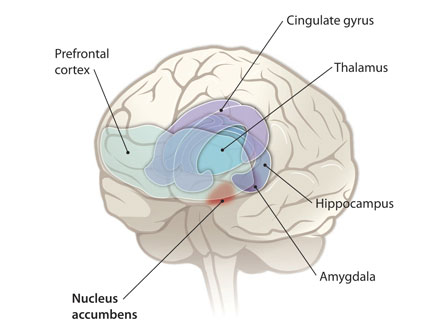- More than 2 years ago
Researchers have pinpointed a region of the brain where scarcity of a key protein may contribute to depression. The new findings, appearing October 20 in Science Translational Medicine, may pave the way to treating some cases of depression with gene therapy.

In the new study, researchers led by Michael Kaplitt of the Weill Cornell Medical College in New York City found that depressed people had lower than normal levels of a protein called p11 in the brain’s nucleus accumbens. This brain structure is important for reward, drug addiction and depression. Delivering the gene for the p11 protein to this region eliminated depression-like behavior in listless mice, the researchers showed.
“We believe that low levels of p11 may be one of the causes of depression in at least some patients,” Kaplitt says. “If we can restore it to normal levels, we can potentially reverse the process.”
Depression is notoriously difficult to treat. “It’s very hard to get people to remission and keep them well with the treatments currently available,” says psychiatrist Madhukar Trivedi of the University of Texas Southwestern Medical Center at Dallas. In a recent large-scale study, about 40 percent of patients with depression who received consistent treatment relapsed within a year. Developing new treatments like the one proposed in the new study is critical, he says.
When Kaplitt and his team lowered the levels of p11 in the nucleus accumbens, mice exhibited behaviors akin to those seen with human depression. These mice quit struggling faster when held by their tails, swam less in water when escape was impossible and drank less sugar water — all signs of despair. Reducing p11 in another region of the brain, the anterior cingulate, didn’t have those effects. An earlier study found that mice lacking p11 throughout their bodies and brains exhibit these same depressed behaviors.
Scientists think that p11 helps brain cells detect the chemical messenger serotonin, an important regulator of mood.
Finding that p11 is required specifically in the nucleus accumbens makes sense, Kaplitt says. “We’re not saying it’s the only area that matters,” Kaplitt says. “But it did say to us that this particular site is important for p11 action.”
The researchers were able to reverse depression-like behavior by adding the p11 gene back to the nucleus accumbens with gene therapy. The team started with mice that had no p11, and then injected a virus carrying the gene into the nucleus accumbens. Cells in the region then began producing p11 protein, and the mice no longer displayed higher signs of despair.
Kaplitt and colleagues also found that p11 levels were lower in tissue taken from the nucleus accumbens of 17 human patients diagnosed with major depression than in 17 matched controls without depression.
A sample size of 17 is small, and the role of p11 in human depression is unclear. “Obviously, certain questions remain,” Trivedi says. “How many patients with major depressive disorder in the community have a p11 deficit?”
Kaplitt and coworkers hope that their findings could guide a human trial using gene therapy to treat depression. In fact, collaborators are already performing experimental p11 gene therapy on primates to see if it is nontoxic and effective. A Phase II clinical trial using a similar gene therapy technique to treat Parkinson’s disease has just ended, Kaplitt says, so he is hopeful that the same kind of trial for depression in humans might be ready to start in one to two years.
Kaplitt is the founder of and a consultant for the Fort Lee, N.J., gene therapy company Neurologix Inc., which holds intellectual property rights to p11 gene therapy treatments.






